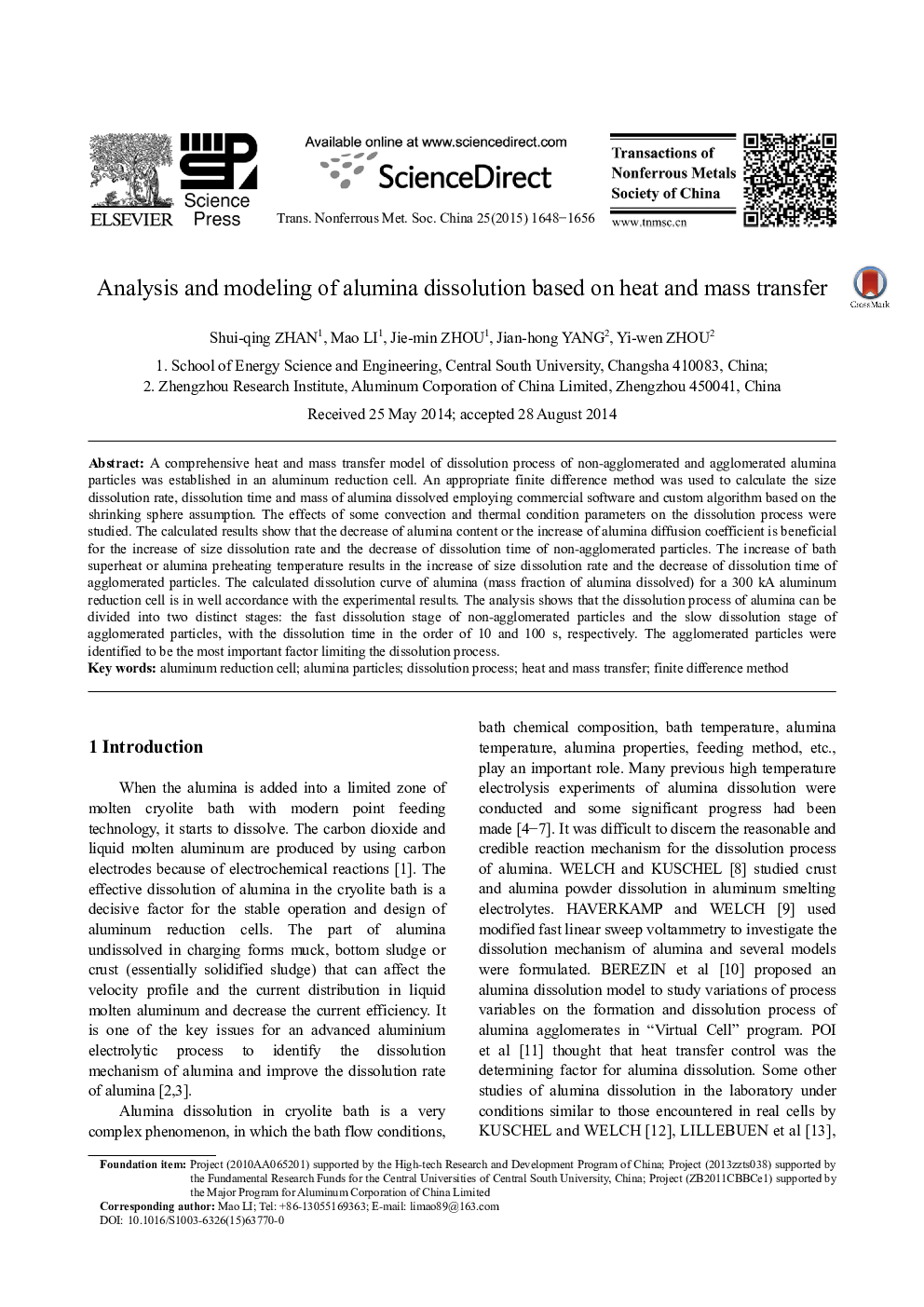| کد مقاله | کد نشریه | سال انتشار | مقاله انگلیسی | نسخه تمام متن |
|---|---|---|---|---|
| 1636681 | 1516957 | 2015 | 9 صفحه PDF | دانلود رایگان |
عنوان انگلیسی مقاله ISI
Analysis and modeling of alumina dissolution based on heat and mass transfer
ترجمه فارسی عنوان
تجزیه و تحلیل و مدل سازی انحلال آلومینا بر اساس انتقال حرارت و جرم
دانلود مقاله + سفارش ترجمه
دانلود مقاله ISI انگلیسی
رایگان برای ایرانیان
کلمات کلیدی
سلول کاهش آلومینیوم، ذرات آلومینا، فرآیند انحلال، انتقال حرارت و جرم، روش متمایز محدود
ترجمه چکیده
مدل جامع انتقال حرارت و جرم فرایند انحلال ذرات آلومینا غیر آگلوموره و آگلومر شده در سلول کاهش آلومینیوم ایجاد شد. برای محاسبه میزان انحلال اندازه، زمان انحلال و جرم آلومینا حل شده با استفاده از نرم افزار تجاری و الگوریتم سفارشی بر اساس فرض حوزه کاهش استفاده شد. اثرات برخی پارامترهای حرارتی و حرارتی در فرایند انحلال مورد بررسی قرار گرفت. نتایج محاسبه نشان می دهد که کاهش مقدار آلومینا یا افزایش ضریب نفوذ آلومینا برای افزایش میزان انحلال اندازه و کاهش زمان انحلال ذرات غیر آگلومریده مفید است. افزایش دمای سوپرایان حمام یا دمای پیش گرم کردن آلومینا موجب افزایش میزان انحلال اندازه و کاهش زمان انحلال ذرات آگلومر شده می شود. منحنی انحلال محاسبه شده آلومینا (قطر جرم آلومینا حل شده) برای یک سلول کاهش دهنده آلومینیوم 300 کیلو وات به خوبی مطابق با نتایج تجربی است. تجزیه و تحلیل نشان می دهد که فرایند انحلال آلومینا را می توان به دو مرحله متمایز تقسیم کرد: مرحله انحلال سریع ذرات غیر آگلوموره و مرحله انحلال آهسته ذرات آگلومرید با زمان انحلال به ترتیب 10 و 100 ثانیه. ذرات آگلومر به عنوان مهمترین عامل محدود کننده پروسه انحلال شناخته شده است.
موضوعات مرتبط
مهندسی و علوم پایه
مهندسی مواد
فلزات و آلیاژها
چکیده انگلیسی
A comprehensive heat and mass transfer model of dissolution process of non-agglomerated and agglomerated alumina particles was established in an aluminum reduction cell. An appropriate finite difference method was used to calculate the size dissolution rate, dissolution time and mass of alumina dissolved employing commercial software and custom algorithm based on the shrinking sphere assumption. The effects of some convection and thermal condition parameters on the dissolution process were studied. The calculated results show that the decrease of alumina content or the increase of alumina diffusion coefficient is beneficial for the increase of size dissolution rate and the decrease of dissolution time of non-agglomerated particles. The increase of bath superheat or alumina preheating temperature results in the increase of size dissolution rate and the decrease of dissolution time of agglomerated particles. The calculated dissolution curve of alumina (mass fraction of alumina dissolved) for a 300 kA aluminum reduction cell is in well accordance with the experimental results. The analysis shows that the dissolution process of alumina can be divided into two distinct stages: the fast dissolution stage of non-agglomerated particles and the slow dissolution stage of agglomerated particles, with the dissolution time in the order of 10 and 100 s, respectively. The agglomerated particles were identified to be the most important factor limiting the dissolution process.
ناشر
Database: Elsevier - ScienceDirect (ساینس دایرکت)
Journal: Transactions of Nonferrous Metals Society of China - Volume 25, Issue 5, May 2015, Pages 1648-1656
Journal: Transactions of Nonferrous Metals Society of China - Volume 25, Issue 5, May 2015, Pages 1648-1656
نویسندگان
Shui-qing ZHAN, Mao LI, Jie-min ZHOU, Jian-hong YANG, Yi-wen ZHOU,
